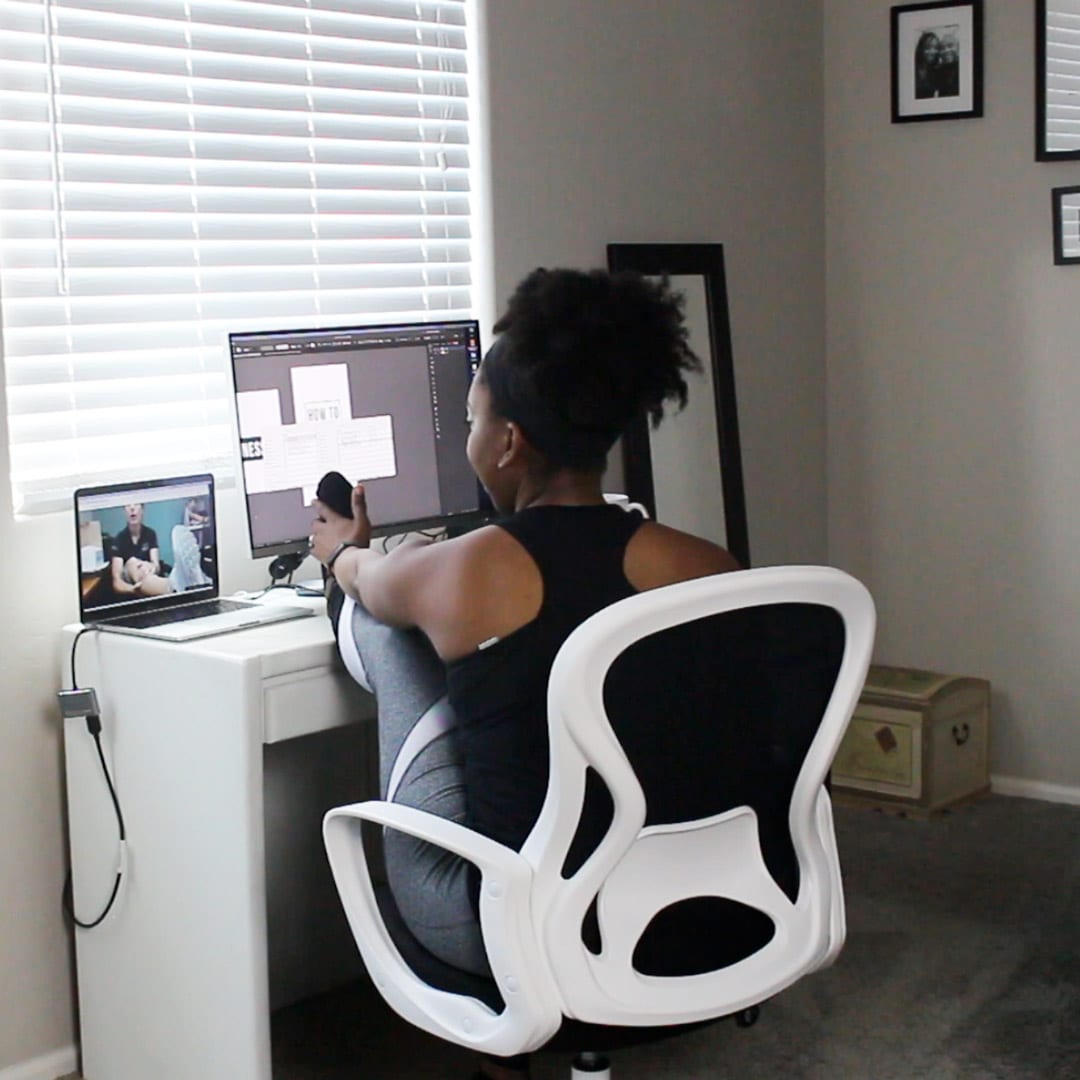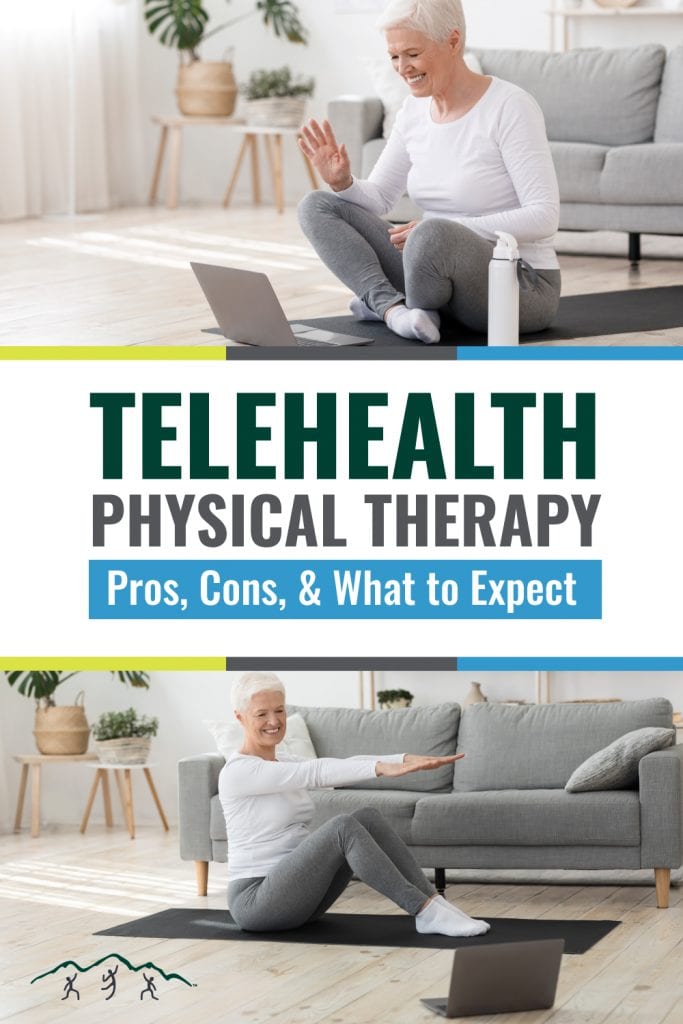Telehealth physical therapy is a great option to get the care you need, virtually. Licensed physical therapists go digital to accommodate patients with different needs and comfort levels. Discover whether virtual physical therapy is the right fit for you.
At the beginning of the pandemic, we were asked the question “Is physical therapy essential?” The medical community responded with a resounding “Yes!”
We’ve continued to stay open, safely, and adjust to the times, continuing to help as many patients as possible.
However, we acknowledge the need for more options, particularly for high-risk patients. And, this is a request we’ve heard from patients with limited time for many years.
Well, here it is: a virtual solution that is quick, inexpensive, and effective!
Many patients have questions about what to expect with virtual care and if it will work for them. I spoke with DPT and clinic director of our Metro Center location, Susie Williams, who has been performing virtual care, to answer our most commonly asked questions and concerns when it comes to virtual care.
Let me tell you, Susie is a gem! Opening her clinic early for at-risk patients, working through her lunch, and always adapting to the latest technology to provide the highest level of care to all of her patients.
It was inspiring to speak with a healthcare provider so passionate about helping her patients. I’m so excited to share with you the details from this amazing conversation. And if you’re in the Metro Center area and looking for care? I cannot recommend Susie enough!
The Best Care Plan for Telehealth Patients
We’ll get into the ins and outs of virtual care, but let’s get right to the point, shall we? Does virtual physical therapy even work?
The answer may surprise you, but we really believe it does! However, we also believe that the best treatment plan includes a blended approach.
To get the most out of your treatment, we prefer to do an in-person initial evaluation to make sure we can accurately diagnose your injury or condition from the get go. After one-two visits, most patients are able to transition to virtual care moving forward.
We understand that some patients feel less comfortable coming into the clinic. In speaking to Susie and other therapists, I learned that many clinics provide accommodations for high-risk patients, bringing them into the clinic before opening, during lunch, or after closing to mitigate their risk and provide the fewest in-person interactions.
Additionally, clients can also request a private treatment room to avoid sharing the space with other patients.
Patient safety is our #1 concern, and we believe this blended approach offers an innovative solution for patients to begin and continue treatment.
What is Telehealth Physical Therapy?

In telehealth physical therapy, you will work with a licensed physical therapist to address your injury and create a rehabilitation plan, just like in-person visits.
The difference? It happens virtually.
In your space. Where you feel comfortable. On your time.
Many patients don’t realize that physical therapy professionals also offer virtual options. While it is newer in practice, as the world changes, we all have to adapt. We’re so proud of the way our therapists have researched, learned, and grown to adapt to a new climate and offer care in a way that’s convenient, effective, and safe.*
*Note: We take the highest precautions to ensure our clinics are safe for the public, including masks, distancing, and all of the sanitizing. We feel strongly that our clinics are safe. However, we respect that physical therapy is not a one-size-fits-all treatment, and we are passionate about providing treatment options for all patients.
Related content >> Foothills At Home
Pros of Telehealth Physical Therapy
There are many reasons virtual physical therapy can be a great choice, pandemic or no pandemic! Let’s take a look at a few of the top reasons patients decide to go virtual.
- Peace of mind for high-risk patients. While we take every precaution inside our clinics to keep patients safe, the risk at home is always the smallest. Staying home helps our high-risk patients continue to receive the care they need without the added stress of leaving home.
- Less expensive. Insurance copays are typically significantly less for virtual care and, sometimes, non-existent! If cost is a concern for your care, virtual PT can be a great solution.
- Shorter appointments. Much of virtual physical therapy is dependent on you completing your home exercise program outside of your appointment time. This means your appointment times are shorter and easier to squeeze in during the workday.
Cons of Telehealth Physical Therapy
While virtual physical therapy is a great solution, there are a few cons compared to in-person therapy.
- Difficult diagnosis. While there is a lot we can do virtually, Susie shares that an initial diagnosis is the most difficult thing to achieve virtually. There is something to be said for being able to feel the way your body works in person.
- Fewer treatment options. While the method of physical therapy is based in strengthening and improving mobility to treat and prevent injuries, there are a lot of great additions to your exercises, such as manual therapy, trigger point dry needling, cupping, and scraping, that you can’t do virtually.
- More time working solo. Virtual PT eliminates the in-clinic time spent doing your exercises with a technician or assistant. Instead, you spend more time completing exercises on your own and checking in with your therapist to make sure your form is correct. It doesn’t offer the same in-the-moment corrections that you receive in the clinic.
Will Telehealth Physical Therapy Work for Me?

Well, it depends.
We wouldn’t offer virtual visits if we didn’t believe in our ability to help patients in this non-traditional format. However, we’re realistic, and we realize virtual sessions are not a fit for every person or every type of session.
Ideal Candidates for Telehealth Physical Therapy
To help you determine whether telehealth is a viable option for your care, Susie helped break it down by who is most likely to see results that are comparable with in-person treatment.
- Athletes. Not just the pros! When we say athlete, we mean any active individual with heightened body awareness. The more in-tune you are with your body, the more likely you will be to achieve a full recovery, virtually.
- Passionate & determined patients. We’ve always seen that patients who take an active role in their recovery have the best outcomes. That becomes even more important when your recovery is reliant on your dedication to your home exercise program and following the recommendations of your therapist without the benefit of manual therapy.
- Technologically-savvy patients. Listen, you don’t need to be a tech wizard to succeed here! What Susie is saying is that patients who are used to Zoom, FaceTime, and other video-related web services typically have an easier time adapting to the technology component.
- Existing patients. If you’ve already been working with a physical therapist, in most cases, it’s really easy and effective to transfer your sessions to virtual care.
- Returning patients. If we’ve already worked with you and know your body, it can also help ease the transition to virtual care.
Related content >> 10 Things I Wish My Patients Knew and Practiced
Ideal Conditions for Telehealth Physical Therapy
Additionally, some injuries and conditions are easier to treat in a virtual setting. Here are the recommendations Susie typically sees success with in a virtual setting:
- New injuries. Meaning, you haven’t been dealing with this pain untreated for years.
- Common athletic injuries. Our therapists are pros at treating things like IT band syndrome, Achilles’ tendonitis, plantar fasciitis, and other common athletic injuries that they see daily. The treatment for these is dialed in and easy to adapt.
Less-Than-Ideal Candidates for Telehealth Physical Therapy
Virtual care isn’t appropriate for every patient. The following patients typically do better with a blended (in-person and virtual) approach or strictly in-person care.
- Brand new patients. If you’ve never been to physical therapy in person before, it will be more difficult to start out virtually. Ideally, we recommend coming in for one or two in-person visits before transitioning to virtual care.*
- Lower-activity patients. If you’re not used to daily activity, the learning curve can be a little bit steeper for a home exercise program. It’s always helpful if we can see you once or twice to make sure you feel comfortable before transitioning to virtual care.
- Less motivated patients. We get it; not everyone loves doing their PT exercises. Coming into the clinic can help motivate patients less inclined to do the work on their own. At the end of the day, it’s your recovery, and you have to take ownership and do the work if you want it to be successful.
- Anyone unable to use a computer, smart phone, or tablet. We know that the technology gap makes this treatment inaccessible to some patients, and we fully acknowledge that it is unfair to lower-income households. Unfortunately, we do not have the ability to loan out technology to complete these visits at this time. Additionally, if you don’t feel confident using a device, virtual care can be stressful and challenging.
*Don’t stress! If you don’t feel comfortable coming into the clinic at all, we can and will still work with you. If you’re dedicated to your results, there is nothing we can’t fix together!
Less-Than-Ideal Conditions for Telehealth Physical Therapy
Some conditions require more manual therapy or are more difficult to diagnose virtually. The following conditions don’t typically resolve without in-person care.
- Untreated long-term conditions: For example, if you’ve been experiencing back pain for five years and never sought help for it, it will be difficult to diagnose virtually. This is a time where it’s best to see the patient in person first, then transition to virtual care once we have a clear diagnosis.
- Post-op. Post-op physical therapy is very specific and requires a lot of manual mobility work. This work is often uncomfortable, making it difficult for patients to do the work on their own. We recommend in-person visits immediately following surgery. You can then discuss transitioning to virtual visits with your therapist when they feel you’re ready.
- Headaches & migraines. For work on headaches and migraines, we typically provide fewer exercises and more manual therapy. Because we can’t do manual therapy virtually, it’s difficult to truly help patients without working on them in person.
Related content >> Can Trigger Point Dry Needling Relieve Tension Headaches?
The Virtual Physical Therapy Process: Step by Step

Now that you know a little more about whether you might be a good candidate for virtual physical therapy, let’s talk about the process from start to finish, from preparing for your first appointment through discharge.
How to Prepare for Your Virtual Visit
Preparing for your virtual visit is not unlike preparing for an in-person visit. Just follow these five simple steps, and you’ll be good to go!
- Remember to fill your paperwork out ahead of time.
- Check your internet connection to make sure you don’t have any connectivity problems.
- Dress in comfortable clothing that’s comfortable for exercise and stretching.
- Find a quiet, open space with good lighting. You want your therapist to be able to see you well, and you want to make sure you have room to move comfortably.
- If this is not your first visit, make sure to have your questions and concerns ready. Even better, write them down so you don’t forget!
What to Expect from Your First Virtual Visit
Your virtual physical therapy visit will be very similar to coming into the clinic. If it’s your first visit, your therapist will perform an injury assessment.
In many cases, therapists can diagnose virtually. However, depending on your injury, your therapist may request that you come in for a quick assessment during a slow time or during off hours in the clinic.
Your therapist will then take you through a series of exercises and make recommendations for which activities are appropriate in your current condition.
If this is a follow-up visit, you will check in with your therapist, discuss how your home exercise program has been going, and ask any questions you have related to your treatment. Your therapist may have you demonstrate some of your exercises to ensure proper form.
The main difference is that your visit will be much shorter since you won’t be working with any technicians or assistants. You can expect initial assessments to take anywhere from 30-60 minutes and follow-up visits to take approximately 15-20 minutes.
Related content >> For the First-Timer: What to Expect at Your First Visit
How Frequent are Virtual Visits?
When you first begin your treatment, it’s likely your therapist will want to see you twice a week to make sure everything is going okay and that your recovery is heading in the right direction.
Once we know things are going well, we typically space out visits to every other week.
Of course, if something changes and you need to be seen sooner, we encourage patients to call and make an appointment. We are diligent about making room for same day or next day visits to ensure our patients are receiving the best care possible.
Expected Outcome of Virtual Physical Therapy
Every physical therapist will tell you something a little different here, as some rely more on manual therapy and some are more strength based.
For ideal candidates and conditions, you can expect to see a full recovery from virtual visits. It may take a little longer, as treatments like manual therapy and dry needling can speed up recovery, but the overall outcomes are comparable with in-person treatment.
For patients whose conditions don’t lend themselves to virtual care, we can still see comparable results using a blended approach of very few in-person visits (remember, we will accommodate you during slower times or even off hours!) combined with virtual care.
However, for post-op patients, the outcomes just aren’t as good. We really need to work hands-on with patients immediately following surgery. Still, we’re happy to work to find your comfort zone during slow or off hours or in a private treatment room.
How to Make Your Virtual Care a Success

Just like in-person visits, and really, with most things in life, the most important thing you can do to make your virtual care successful is take ownership in your recovery!
Similar to online education, you get out of virtual care what you put in. Here are a few tips to guarantee successful treatment:
- Do your homework. Seriously. If you don’t do your home exercise program, you won’t get better doing virtual care.
- Listen to your therapist. If they tell you to stay off your sprained ankle, going for a run the next day is not advised.
- Bring your questions. With biweekly visits, it’s important to maximize your time with your therapist. Between visits, write down your questions so you remember them and have them ready for your appointment.
Telehealth Physical Therapy FAQs
Will I be able to keep seeing my current therapist?
Yes! Continuity of care is extremely important to us, and we take every measure to ensure you are not passed off between therapists.
How long will my virtual session take?
Initial assessments take 30-60 minutes. Follow-up visits take 15-20 minutes.
How much will I be charged for my virtual visit?
Telehealth copays are typically lower than in-person visits. Many insurance companies don’t require a copay at all, and Susie said that she hasn’t seen a copay from any insurance company go over $30.
With fewer sessions and lower copays, virtual care is a great option for patients who find care to be cost prohibitive.
If you don’t use insurance, our cash pay fee for virtual care is $35 for sessions under 30 minutes and $70 for sessions 30-60 minutes.
Will I need any special equipment?
Nope! It’s our therapists’ job to make sure you can do everything you need with whatever you have.
Susie will occasionally suggest exercises that require bands. In that case, she will have bands cut, ready, and waiting at the front desk for clients to pick up during slow hours to limit exposure.
Will I get better?
We hope so!
Unfortunately, it’s impossible to answer that without evaluating your individual condition. However, yes, we do see great outcomes using virtual care!
How do I schedule a virtual appointment?
Glad you asked!
You can go directly to our “request a referral” page and select “video conference”. Alternatively, you can call in and request to make a virtual appointment with your therapist.

Ready to get started? Schedule your visit (virtual or in-person) today!

Source: Susie Williams, DPT




